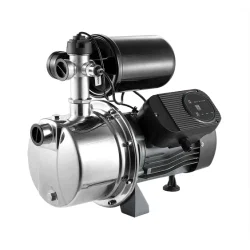Operation of Automatic Jet Pumps
2024-05-30
An automatic jet pump is a type of water pump used to draw water from a well, cistern, or other water source and deliver it to a building's plumbing system or water distribution network. Unlike traditional jet pumps, which require manual priming to start and maintain water flow, automatic jet pumps feature built-in controls and mechanisms that automate the priming and operation process. Here's an overview of automatic jet pumps, including their features, operation, and applications:
Features of Automatic Jet Pumps
1. Dual Pipe System: Automatic jet pumps utilize a dual pipe system consisting of a suction pipe (or jet) and a discharge pipe. The suction pipe extends into the water source, while the discharge pipe delivers water to the building's plumbing system.
2. Impeller and Diffuser: Inside the pump housing, an impeller and diffuser work together to create suction and draw water from the source into the pump.
3. Pressure Switch: Automatic jet pumps are equipped with a pressure switch that monitors the water pressure in the system. When water demand drops below a certain level, indicating that the system needs more water, the pressure switch activates the pump to start drawing water from the source.
4. Built-in Priming Mechanism: Automatic jet pumps feature a built-in priming mechanism, such as a venturi or injector, that automatically primes the pump and maintains water flow without the need for manual priming.
5. Pressure Tank: Many automatic jet pump systems are paired with a pressure tank, which stores pressurized water and helps regulate water pressure in the plumbing system. The pressure tank allows the pump to cycle on and off as needed to maintain consistent water pressure.
6. Thermal Overload Protection: Some automatic jet pumps are equipped with thermal overload protection to prevent overheating and motor damage during extended periods of operation or in the event of a malfunction.
7. Corrosion-resistant Construction: Automatic jet pumps are typically constructed from durable and corrosion-resistant materials, such as stainless steel or thermoplastic, to withstand exposure to water and harsh environmental conditions.
Operation of Automatic Jet Pumps
1. Priming: When water demand triggers the pump to start, the built-in priming mechanism activates, creating suction and drawing water from the source into the pump.
2. Water Delivery: The impeller and diffuser work together to pressurize the water and deliver it through the discharge pipe to the building's plumbing system.
3. Pressure Regulation: As water is drawn from the source and delivered to the plumbing system, the pressure switch monitors the system's water pressure. When the pressure drops below a preset level, indicating that more water is needed, the pressure switch activates the pump to continue pumping water.
4. Cycling: The automatic jet pump cycles on and off as needed to maintain the desired water pressure in the system. When water demand decreases and the pressure reaches the preset cutoff point, the pump shuts off until the pressure drops again and additional water is required.
Applications of Automatic Jet Pumps
1. Residential Water Supply: Automatic jet pumps are commonly used in residential water supply systems to draw water from wells, cisterns, or underground sources and deliver it to the home's plumbing fixtures, faucets, and appliances.
2. Agricultural Irrigation: In agricultural settings, automatic jet pumps are used to supply water for irrigation systems, livestock watering, and other agricultural applications.
3. Commercial and Industrial Applications: Automatic jet pumps are also used in commercial and industrial settings to provide water supply for buildings, facilities, and manufacturing processes.
4. Water Transfer: They can be used for water transfer applications, such as filling tanks, ponds, or swimming pools, and for dewatering flooded areas.
5. Booster Pump Systems: Automatic jet pumps are sometimes used as part of booster pump systems to increase water pressure in buildings with low water pressure or to overcome height differences in multi-story buildings.
Conclusion
Automatic jet pumps are versatile water pumps that automate the process of drawing water from a source and delivering it to a building's plumbing system or water distribution network. With built-in controls, priming mechanisms, and pressure regulation features, they provide reliable and efficient water supply solutions for residential, commercial, agricultural, and industrial applications. When selecting an automatic jet pump, consider factors such as flow rate, pressure capacity, motor power, and construction materials to ensure compatibility with the specific requirements of your water supply system. Proper installation, maintenance, and monitoring are essential to ensure optimal performance and longevity of the pump system.



